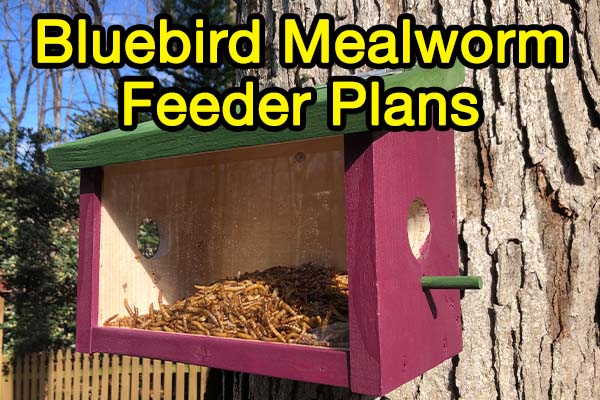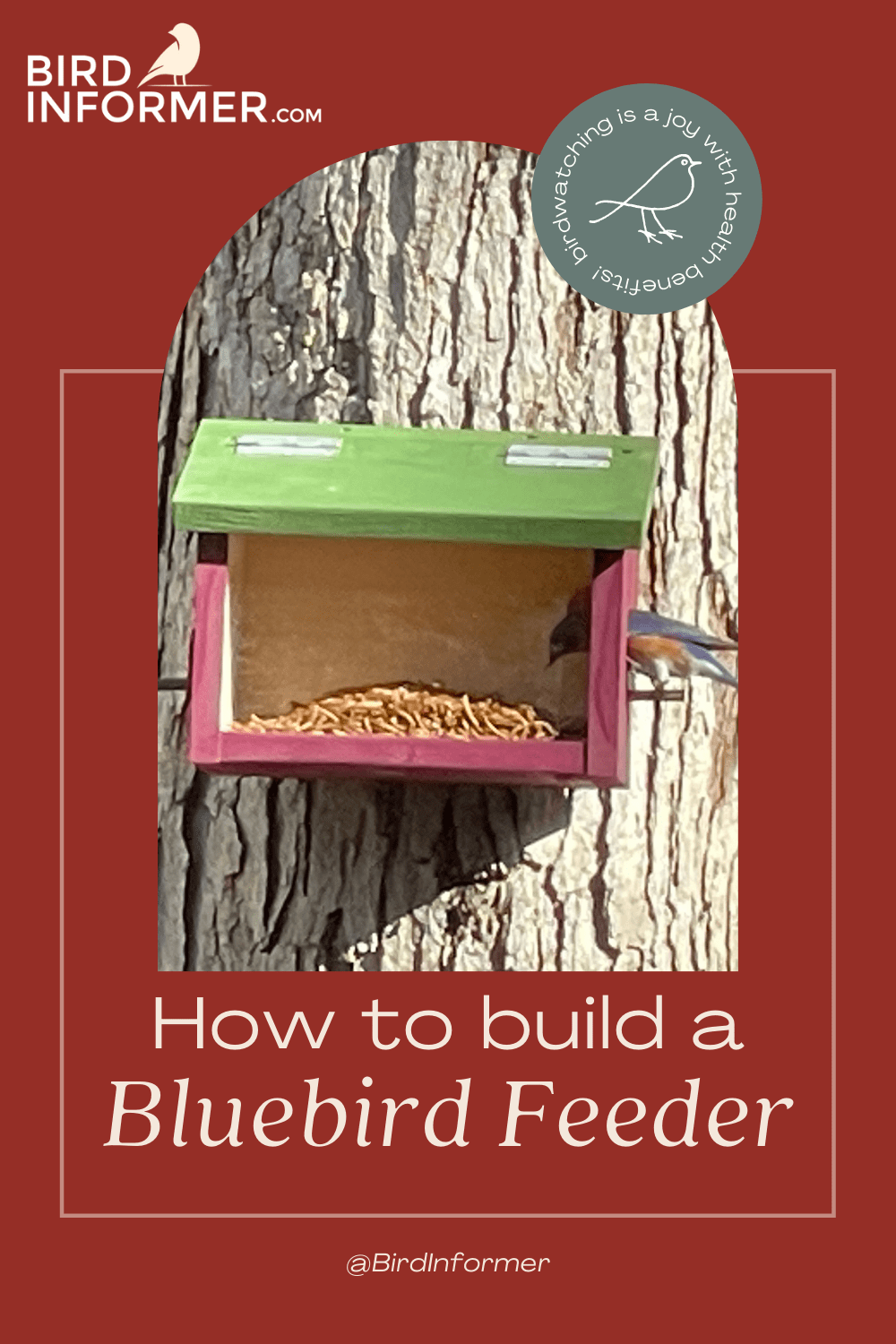Contents
- Bluebird Feeders
- Bluebird Bird Feeder Plan Download & Step By Step Instructions
- Download FREE Bluebird Feeder Plans & Material List
- Tips To Entice Bluebirds To Your Yard
- Eastern Bluebird FAQs
- Final Thoughts On How To Build A Bluebird Feeder
Do you want to attract the Eastern bluebird to your backyard? If so, you’ll need a bluebird feeder, ideally one that can hold meal worms to feed bluebirds. Here, I will give you step-by-step instructions on how to create your very own bluebird feeder with our unique bluebird feeder plans, proven to attract eastern bluebirds, just watch the video below 🙂
Bluebird Feeders
The Eastern bluebird does LOVE to eat dried mealworms. The ones we use are Kimoe dried mealworms and we buy them in 10lb bags from Amazon. They have proven to be very effective in attracting bluebirds for us!
One thing that I have been challenged with is wet weather. I have some mealworm dish feeders that work great when the sun is shining, BUT… when it rains, the mealworms get nasty!
And,
I also wanted a bluebird feeder that would keep squirrels away! So, I built the wood feeder highlighted here, complete with entrance holes & perch, clear plexiglass, and a roof to keep out the rain.
Bluebird Bird Feeder Plan Download & Step By Step Instructions
Download our bluebird feeder plans by simply providing your name and email. We’ll email you the PDF plans instantly, complete with a materials and cutting list.
Download FREE Bluebird Feeder Plans & Material List
Get started now with our free plans so you can build your very own bluebird feeder in just a few hours!
- Inexpensive
- Fun
- Proven that it works!
Simply complete the form on this page to get your PDF plans emailed directly to your inbox.
Once you have the plans and have purchased all your materials, you can get started by following these steps:
Step 1: Cut all your pine pieces to size.
Using our cutting sheet, measure all your pieces. Double-check all measurements before cutting! You know what they say… measure twice, cut once!
Here are a few pointers:
- Take your time
- Be sure that the top edge of the back wall is cut at the same angle as the roofline (22.5°)
- Dry fit the sides & bottom before cutting the kerf slot for the plexiglass. Mark the sides with a pencil so you are 100% sure what is the inside edge of the side walls. This way you make the kerf cut on the correct side.
- Make sure that the roof has the back edge cut with a 22.5° angle so it sits flush with the back.
- Cut the roof for the hinges at the same 22.5° angle. Mark the side with a pencil, indicating the direction of the angle so you don’t make a mistake.
- Use a Forstner drill bit to make the holes. Don’t use a spade bit as that will tear out the backside of the wall. And, be sure to clamp the side pieces prior to drilling the holes. Another tip… clamp both pieces together and drill your holes through both pieces at one time.
- We opted for 1.5″ diameter holes so they are big enough for bluebirds but small enough to prevent bigger birds from entering.
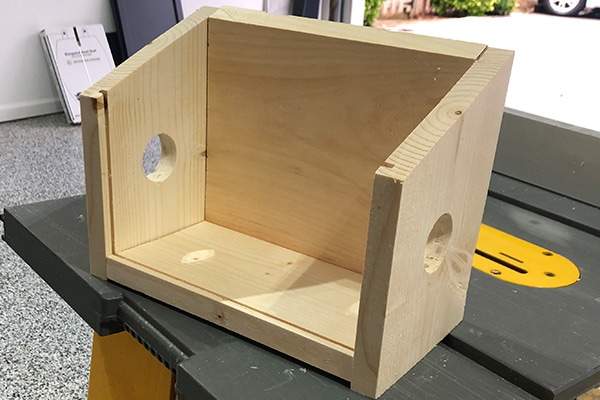
Step 2: Sand everything, making sure you have completely smooth sides.
Be sure to sand all edges smoothly. I used 150 grit sandpaper. I paid special attention to the entrance holes as I wanted to make sure there were absolutely no rough edges that could harm the birds.
Step 3: Assemble the wooden pieces
I assembled everything with no glue. I used SPAX outdoor screws since these are very easy to work with. But, if you prefer, you can assemble with glue and nails as well.
Assemble in this order:
- Attach a side to the bottom
- Attach the next side to the bottom
- Attach the back wall to the bottom and the left & right sides
- Attach the stationary portion of the roof to the back & two sides. Be sure to leave the same overhand on the left and the right. The back should be flush with the back wall.
- Attach the moveable portion to the stationary section using 2 hinges. It is helpful having a second set of hands to hold the roof while you secure the hinges.
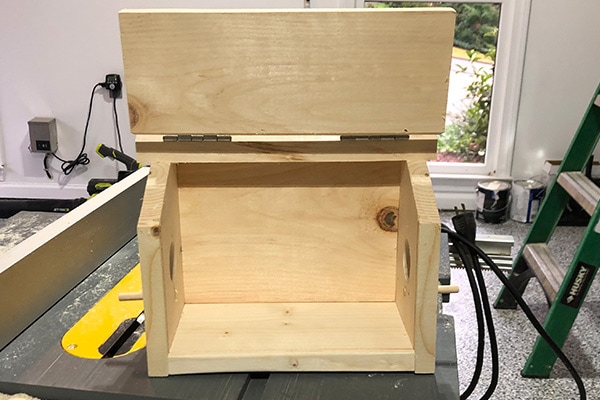
Step 4: Cut the plexiglass, sand & test for fit
Using a table saw, cut the plexiglass to size. Keep the protective covering on the glass to prevent scratching it.
Once the glass is cut, test to make sure the glass fits correctly into the feeder. Then, use sandpaper to smooth all edges.
As you can see in this picture, I actually cut the plexi prior to assembling the wood. You can do that as well.
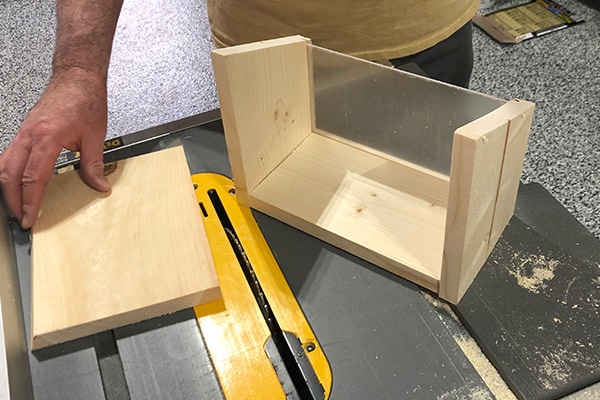
Step 5: Paint the birdfeeder
We decided to add some color to our feeder. We used One Decor Paint (craft paint & sealer) and only painted the outside. I think this will keep the feeder good for year round usage. However, I have debated covering the roof with little shingles. Perhaps on my next one!
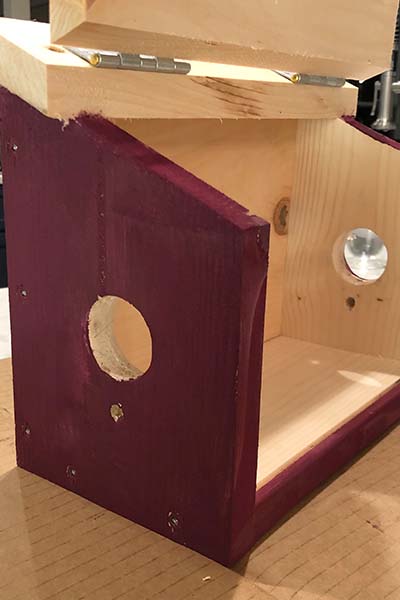
Step 8: Install your new feeder
After the paint has completely dried, it’s time to install your new mealworm feeder! I found a location in my yard where I would be able to watch the bluebirds from my kitchen. Then I simply screwed the feeder into a tree with two 3″ long screws.
Once the feeder is secured on the tree:
- Slide the plexiglass into position
- Open the roof
- Fill with food. We opted for dried mealworms since we know that bluebirds absolutely love feeding on these worms. I might try to add live mealworms at some point in the future.
As you can see by the video at the top of this page, we were successful by the number of attracted bluebirds to this bluebird feeder. It did take the birds a day or two before they used the entrance holes to go totally inside. And, I am pleased to report that larger birds and squirrels have stayed completely away from this feeder that looks somewhat like birdhouses.
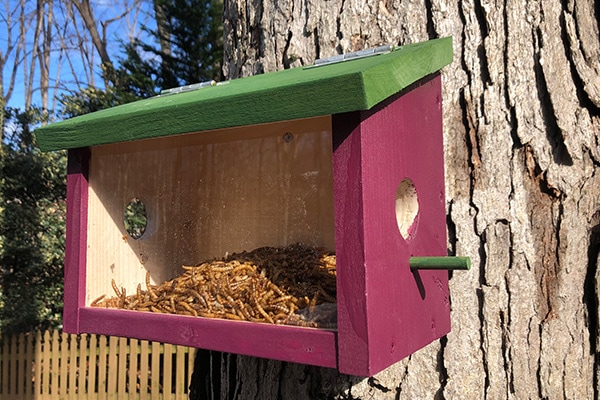
Future Enhancements:
I am thinking about having small holes drilled into the bottom of the feeder to promote some good air circulation. I’m also going to use small roofing shingles and small siding to visually enhance my next birdfeeder! That will add quite a bit of time to the build process but I am sure the result will be worth it.
Best Bluebird Bird Feeders
Aside from the DIY bird feeder on this page, other great bluebird feeders include the one below as well as the birdfeeders highlighted on our bluebird feeder buyer’s guide page.
The Gilbertson Feeder
This is a very unique feeder and I will create plans for my own DIY version in the near future. I like the fact that this feeder is an open-air feeder and also will prevent squirrels from accessing the feed. However, I’d have to install this on a fixed pole. Otherwise, I am sure that squirrels will simply tip a hanging feeder to force all the feed to fall to the ground.
Suet Cakes Bird Feeder
I have tried many different suet feeders and they are enticing for bluebirds as well as other birds. I use suet cakes that are made from mealworms as they are much more effective at attracting bluebirds.
Wreath Bird Feeder With Suet Balls
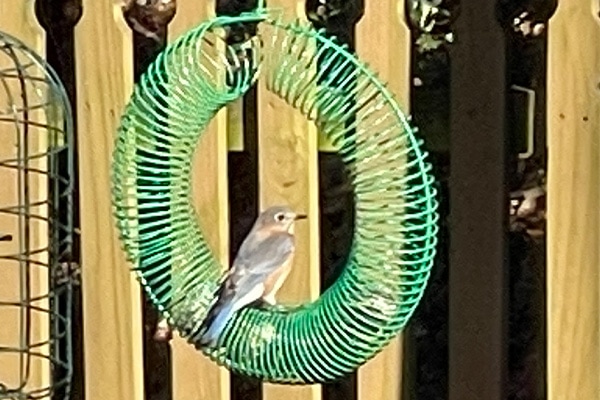
I have one of these in my yard and they do attract bluebirds as well as woodpeckers and other birds. The wreath feeder I use is Pacific Bird & Supply Green Ring Suet Ball Bird.
Meal Worm Dish Tray Feeder
These are easy feeders to use but the trays are exposed to the rain. I currently have one in my backyard and have installed a plastic dome cover in an effort to keep the rain out. Another downside to this style of dish feeder is the limited capacity for feed. Typically the tray or the dish is fairly small.
Tips To Entice Bluebirds To Your Yard
Add a Bluebird House
Create an environment appealing to bluebirds by adding a birdhouse that will attract them to your backyard oasis.
Eastern Bluebird FAQs
How big should the hole be for a bluebird feeder?
1-1/2″ diameter holes work great for bluebirds. That is the size that we recommend on your feeders and that is what is specified on these plans.
What type of feeder do bluebirds like?
Bluebirds enjoy feeding in enclosed, birdhouse-styled feeders, as well as Gilbertson-styled, suet-styled & hanging tray/dish-styled feeders.
What are the best bluebird feeders?
IMO, the best bluebird feeders are ones that offer mealworms and that work best for your backyard, well suited for your environment. I have found all the ones highlighted on this page to work well for us and we enjoy watching bluebirds (birds from other species as well) on our feeders every day!
Where is the best place to put a bluebird feeder?
The best place to install your feeders is in an area that is close to shrubs, trees, and other protective foliage. Bluebirds like to fly from protected areas to the feeders and then back to their protected areas to stay away from predators.
I especially like the birdfeeder plans on this page as it provides an area for bluebirds to feed inside a “shelter”.
What do you feed bluebirds?
Like many other birds, Bluebirds love mealworms (dried & live), suet dough, sunflower seed, and fruit.
Final Thoughts On How To Build A Bluebird Feeder
This is an inexpensive project that lets you enjoy the magic of Eastern bluebirds in your own backyard and can be completed in just a few hours.
Birdwatching brings joy, pleasure & relaxation. And, this is a great way to enjoy watching birds feeding on mealworms from one of your very own creations.
Please feel free to contact us with any suggestions for improvements or other content you would like us to post.
Happy Birding!

